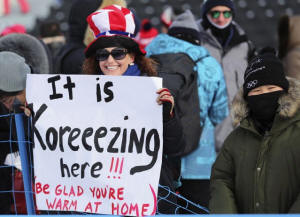|
Wind,
snow and frozen phones: How to survive the coldest Olympics
 Send a link to a friend
Send a link to a friend
 [February 17, 2018]
By Darren Schuettler [February 17, 2018]
By Darren Schuettler
PYEONGCHANG, South Korea - Before the
Pyeongchang Winter Olympics began on Feb 9, Magnus Strom and his
Reuters colleague Sylvain Marchandise, both experienced skiers,
spent five days on a frigid mountain, skiing to locations on the
alpine skiing course. They laid hundreds of meters of cable a day so
Reuters journalists can send pictures and text stories down from the
slopes to editors in the media center.
The weather was a bone-chilling, minus 20 degrees Celsius (minus 4
Fahrenheit).
“The cables can just snap because it’s so cold,” Strom said.
The Pyeongchang games in South Korea are predicted to be the coldest
since the 1994 games in Lillehammer, Norway, made tougher by strong
winds battering the host city in the mountains. Gusts of up to 39
knots (72 kilometers per hour) caused several alpine events to be
postponed during the first week.

(Graphic – Winter Olympics temperatures - http://tmsnrt.rs/2joGGwO)
“These are by far the harshest conditions we have worked in,” said
Andrew Edgington, team leader of 12 Reuters technicians who laid
more than 14,000 meters of cable at indoor and outdoor venues across
the sprawling Olympic site. “We have had some staff outside for over
12 hours in freezing temperatures.”
At the Olympic Stadium, technicians in safety harnesses climbed up
to the open roof and onto catwalks to install robotic cameras for
covering the opening ceremony. The team also set up outdoor
positions for photographers covering snowboarding, freestyle skiing,
ski jump, sliding and Nordic events.
[to top of second column] |

Pyeongchang 2018 Winter Olympics - Men's Slopestyle Finals - Phoenix
Snow Park - Pyeongchang, South Korea - February 11, 2018 -
Spectators wait in the cold. REUTERS/Mike Blake

“This is very much a group effort by the technical team,” Edgington
said.
For journalists working outdoors, especially at the ski and sliding
events, Reuters provided heavy-duty blue parkas with the Reuters
logo. Everyone also had a list of must-have items that included
thermal underwear, fleece clothing, and insulated, waterproof boots
with soles that could grip ice and snow.
Ink in pens can freeze when the mercury plummets, so all reporters
working outdoors are equipped with pencils and pocket-sized
notepads, still the most reliable method of note-taking. Fingerless
gloves are one's friend because it is hard to grip a pencil wearing
ski gloves.
Reporters also keep hand warmers in their coat pockets, not for
their hands but for their phones. A phone battery can drain in
minutes when the temperature drops below minus 25 degrees Celsius.
(Reporting by Darren Schuettler; Editing by Lauren Young and Toni
Reinhold)
[© 2018 Thomson Reuters. All rights
reserved.] Copyright 2018 Reuters. All rights reserved. This material may not be published,
broadcast, rewritten or redistributed.
Thompson Reuters is solely responsible for this content.
 |